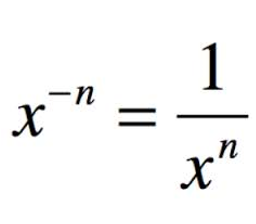Negative Exponent: Definition & Rules
Negative exponents have caused problems for math students as long as they have been defined. This lesson will shed some light on the negative exponent: what it means and how to work with it in a math problem.
What are Exponents?
Exponents are numbers that are written as a superscript. The exponent tells a mathematician how many times a certain number should be multiplied to itself. For example:
2^3 = 2*2 *2 = 8
The word exponent is from the Latin expo, meaning out of, and ponere, meaning place. The first recorded modern usage of the concept was in the 1500's. However, the concept of squared and cubed numbers dates back to ancient Babylon.
Exponents are useful mathematical and scientific shorthand. Where it would be very confusing to try and perform mathematical calculations with numbers such as 602,000,000,000,000,000,000,000, it becomes not so bad if the number is written as 6.02*10^23.
Negative Exponents
Negative exponents are exactly what they are named; they are exponents that happen to be negative.
2^-3
In mathematics, this is not proper form for writing a number with an exponent, so the expression must be rewritten in its proper form.

The best way to remember how to deal with a negative exponent is to remember that negative is the opposite of positive and division is the opposite of multiplication, so a number with a negative exponent should be moved to the denominator of a fraction and the exponent switched to positive. The opposite is also true. If the negative exponent is in the denominator of a fraction, its expression gets moved to the numerator and the sign of the exponent is changed.
That way
2^-3
becomes
1/2^3
What about something more complicated?
-5y^-3 z^5
becomes
-5z^5/y^3
And
2x^-3/y^2 z^-2
is
2z^2/x^3 y^2
Working with Negative Exponents
The rules of exponents, especially the product rule, still apply even if you are working with negative exponents.

Here is an example problem: